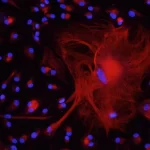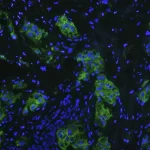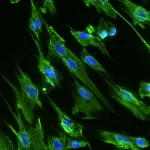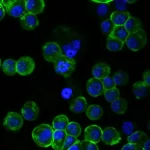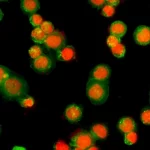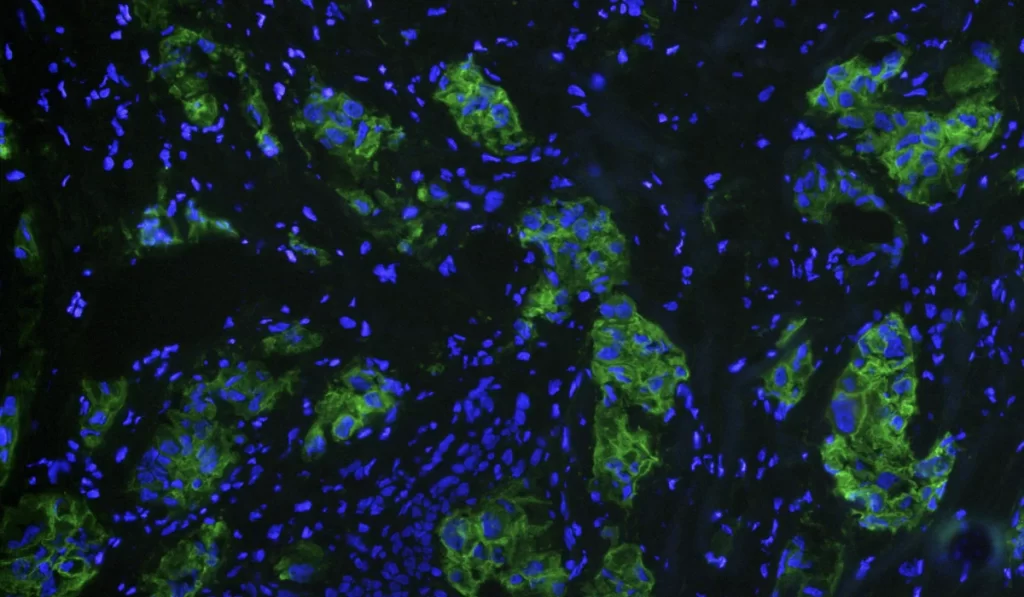
Product Name: Mouse Anti-Human CD9 |
|---|
Product Number: PDZMM |
Clonality: Monoclonal |
Conjugation: Unconjugated |
Host Species: Mouse |
Target Species: Human |
Mouse Anti-Human CD9
- Background
- Product Details
- Storage & Handling
- Applications
- Protein Background: Provide a concise description of Fibromodulin, e.g., “Fibromodulin, encoded by the FMOD gene, is a 42kDa protein and a member of the leucine-rich repeat proteoglycans (SLRPs). It plays a role in cell growth and differentiation and shares sequence homology with biglycan and decorin.”—Briefly explain if the antibody is specialized or optimized, highlighting any unique manufacturing processes that enhance quality or effectiveness (Production Background).
- Immunogen: Describe immunogen used, e.g., “A KLH-conjugated synthetic peptide from human Fibromodulin.”
- Purification: This product was prepared using immunoaffinity chromatography with an immunogen peptide derived from the N-terminal region of human β-actin, coupled to Sepharose 4B.
- Storage & Handling: Store at -20°C upon receipt. Avoid repeated freeze-thaw cycles. The product is stable for several weeks at 4°C as an undiluted liquid.
- Storage Buffer: 10 mM sodium HEPES (pH 7.5), 150 mM NaCl, 100 µg/ml BSA, and 50% glycerol. For extended storage, aliquot and store at -20°C or below. Centrifuge if product is not completely clear after standing at room temperature.
Suitability Applications:
- Western Blotting (WB)
- Immunohistochemistry (IHC-P, IHC-Frozen)
- Dot Blot
- Immunomicroscopy
- Immunofluorescence
- Flow Cytometry
- ELISA
Application Notes:
- Optimal dilutions should be determined by the end-user based on experimental conditions. Recommend users start with suggested dilutions but adjust as necessary.
- Western Blotting: 1/2000
- IHC (Paraffin/Frozen): 1/2000
- The Mouse Anti-Human Beta-Actin-HRP antibody has received positive feedback from customers. However, if it fails to give results, please contact Padza’s scientific support team for assistance.
- “FOR RESEARCH USE ONLY. NOT FOR USE IN DIAGNOSTIC PROCEDURES.”
Overview
The Mouse Anti-Human Beta-Actin-HRP monoclonal antibody is specifically designed to detect human β-actin, a protein that is a major component of the cytoskeleton and widely expressed in various mammalian tissues. It is conjugated with Horseradish Peroxidase (HRP), which is useful for detection via chemiluminescence or colorimetric methods in techniques such as Western Blotting and Immunohistochemistry.
- Published Studies: We will update this section with studies where this antibody was successfully used. (“This antibody was featured in Journal XYZ, 2023, in studies on targeted immunotherapy.”)
References
- Herman, I.M. (1993) Curr Opin Cell Biol 5, 48-55.
- Condeelis, J. (2001) Trends Cell Biol 11, 288-93.
- Lim, Y.P. et al. (2004) Clin. Cancer Res. 10, 3980-3987.
- Kayalar, C. et al. (1996) Proc. Natl. Acad. Sci. USA. 93, 2234-2238.
- Communal, C. et al. (2002) Proc. Natl. Acad. Sci. USA. 99, 6252-6256.
- Du, J. et al. (2004) J. Clin. Invest. 113, 115-123.
(You can view the article referenced in the NCBI: PMC4137948)
- Case Studies: Brief summaries of key research projects or notable outcomes demonstrating the product’s effectiveness.
📄 Submit your research to feature here!
Publications & Research
Ordering Information
Sizes and Packaging Options: Various sizes (50 µL, 100 µL) and larger quantities are available.
Sizes | Ordering Code | Packaging | Availability |
50 µL | PDZMM101-50 | Standard vial | Order Now |
100 µL | PDZMM101-100 | Standard vial | Order Now |
💬 Request a Quote for Bulk Purchases
PADZA ensures product performance when purchased directly from PADZA or authorized distributors. Contact our scientific support team for any technical issues.
📩 Contact our Scientific Support Team for application-specific queries or troubleshooting.
Terms & Conditions: This product is guaranteed only when purchased directly from PADZA or its authorized distributors.
Contact Padza for Product Support and Inquiries
At Padza, we are committed to providing exceptional support for our products and services. Whether you have feedback, need assistance with an application, or require technical troubleshooting, our team is here to help. Please fill out the form below to get in touch with us, and our technical experts will respond promptly to assist with your specific needs. We look forward to supporting your research and ensuring the success of your projects.
Suggested Products
Explore our selection of related antibodies and products tailored for human target research. Browse through our collection of SLRP antibodies, conjugated forms, and other specialized antibodies that complement your application needs. We’ve also included additional products such as apoptosis kits, designed to enhance your research. Use the carousel or grid below to easily find relevant solutions that work seamlessly with your current selection.

